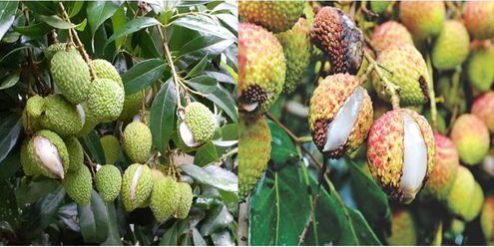Litchi is a delicious, juicy fruit loved by many. But if you grow litchis, you may have noticed a frustrating problem—fruit cracking. It’s when the outer skin of the litchi splits before harvest, ruining the appearance, reducing market value, and even affecting the taste and shelf life.
This problem is not just occasional. In fact, in many litchi-growing countries, up to 70% of the fruits can get damaged due to cracking. That’s a huge loss for farmers and backyard growers alike. The good news? This issue is manageable. You just need to understand the causes and take the right steps at the right time.
In this post, we’ll explore what causes fruit cracking in litchi and how you can reduce it using practical and easy-to-follow methods. Whether you’re a small-scale grower or managing a large orchard, this guide will help you protect your litchi harvest.
Fruit cracking in litchi refers to the breaking or splitting of the fruit’s outer skin before it reaches full maturity. It usually happens during the fruit development stage, especially when the weather or soil conditions fluctuate too much.
While it may seem like a simple cosmetic issue, fruit cracking has serious effects:
- It reduces the market value of your fruit.
- Cracked fruits have shorter shelf life and attract pests more easily.
- It increases the chance of storage diseases, making them unsafe for transport or sale.
Understanding the cause of fruit cracking in litchi is the first step toward preventing it.
Common Causes of Fruit Cracking in Litchi
There isn’t just one reason for this problem. A mix of environmental, nutritional, and biological factors usually causes it. Here are the main culprits:
Prolonged Drought or Hot Winds
Dry and hot conditions, especially just before harvest, can cause sudden pressure changes inside the fruit. When water becomes available suddenly (like after irrigation), the pulp expands quickly, and the skin can’t keep up—resulting in cracks.
Nutrient Deficiency
Lack of important micronutrients like boron and calcium can weaken the skin of the fruit, making it more likely to crack.
Physiological Imbalances
Sometimes the plant’s own growth processes go out of sync due to stress, poor soil, or irregular watering. This imbalance leads to weak fruit development.
Insect or Mite Attacks
Pest attacks can damage the fruit surface or stress the tree, making it more vulnerable to cracking.
Effective Ways to Manage Fruit Cracking in Litchi
The good news is that you don’t need expensive tools or treatments to manage this problem. With consistent care and by following the right techniques, you can go a long way.
Fertilize Smartly Throughout the Year
Apply a balanced mix of organic and chemical fertilizers based on your tree’s age and condition. Fertilization should be done in three stages:
-
At the beginning of the monsoon
-
At the end of the monsoon
-
Just after flowering
This ensures the plant gets the nutrients it needs for healthy fruit development.
Maintain Regular Irrigation
After fruit sets, make sure to water your litchi trees every 10–15 days during the dry season. This prevents the sudden intake of water that leads to cracking. Consistent moisture keeps both the pulp and skin growing at the same pace.
Use Mulch to Retain Soil Moisture
In dry weather conditions, apply mulch like straw or water hyacinth around the base of the litchi tree after each irrigation to help retain soil moisture and prevent cracking. This keeps the soil moist for longer and protects the roots from sudden temperature changes.
Provide Calcium Support
Apply dolomite lime (Dolochun) at 50 grams per tree every year at the base. Calcium helps strengthen the cell walls in the fruit skin, reducing the risk of cracking.
Spray Zinc During Fruit Growth
Zinc is important for fruit firmness. Mix 10 grams of zinc sulphate per liter of water and spray it on the plants every 21 days during the fruit development stage.
Use Plant Growth Regulators
To minimize fruit cracking in litchi, spray Planofix or Miraculan or Boom Flower or Flora at a concentration of 2 ml per 4.5 liters of water immediately after fruit set. These helps reduce physiological stress and improve fruit quality.
Apply Boron to Strengthen Fruit Skin
Mix boric acid or Solubor boron at 2 grams per liter of water and spray it three times at 10–12 days intervals during the fruit development stage. Boron is essential for maintaining cell wall strength and flexibility in litchi fruits, helping reduce the risk of fruit cracking.
Watch for Pests and Mites
Check your trees regularly. If you see signs of insect or mite attack—like curled leaves, discolored fruit, or tiny holes—take quick action using natural or recommended pesticides. Early treatment can prevent further stress on the tree.
Final Thoughts
Litchi fruit cracking may seem like an overwhelming issue, but with a bit of attention and timely care, it can be controlled. Regular watering, balanced nutrition, and proactive monitoring can save a big portion of your harvest.
If you’re consistent with the practices mentioned above, you’ll likely see healthier fruits, better yields, and fewer losses. Litchi farming doesn’t have to be unpredictable—just a little care goes a long way!
Want more practical tips like this? Explore our other posts on managing fruit trees and boosting your orchard’s productivity.
FAQ: Frequently Asked Questions
What is fruit cracking in litchi?
Fruit cracking in litchi refers to the splitting of the fruit’s skin before maturity, usually due to sudden moisture or nutrient imbalance.
How does fruit cracking affect litchi quality?
It reduces shelf life, market value, and makes the fruit more prone to pests and diseases during storage.
Can litchi fruit cracking be prevented?
Yes, it can be managed with balanced fertilization, proper irrigation, boron and calcium support, and timely pest control.
When should I apply boron to prevent litchi fruit cracking?
Spray boric acid or Solubor at 2 g/L, three times at 10–12 day intervals during fruit development.
What is the role of mulch in managing litchi fruit cracking?
Mulch helps retain soil moisture after irrigation, reducing stress on the fruit skin and preventing sudden expansion.









